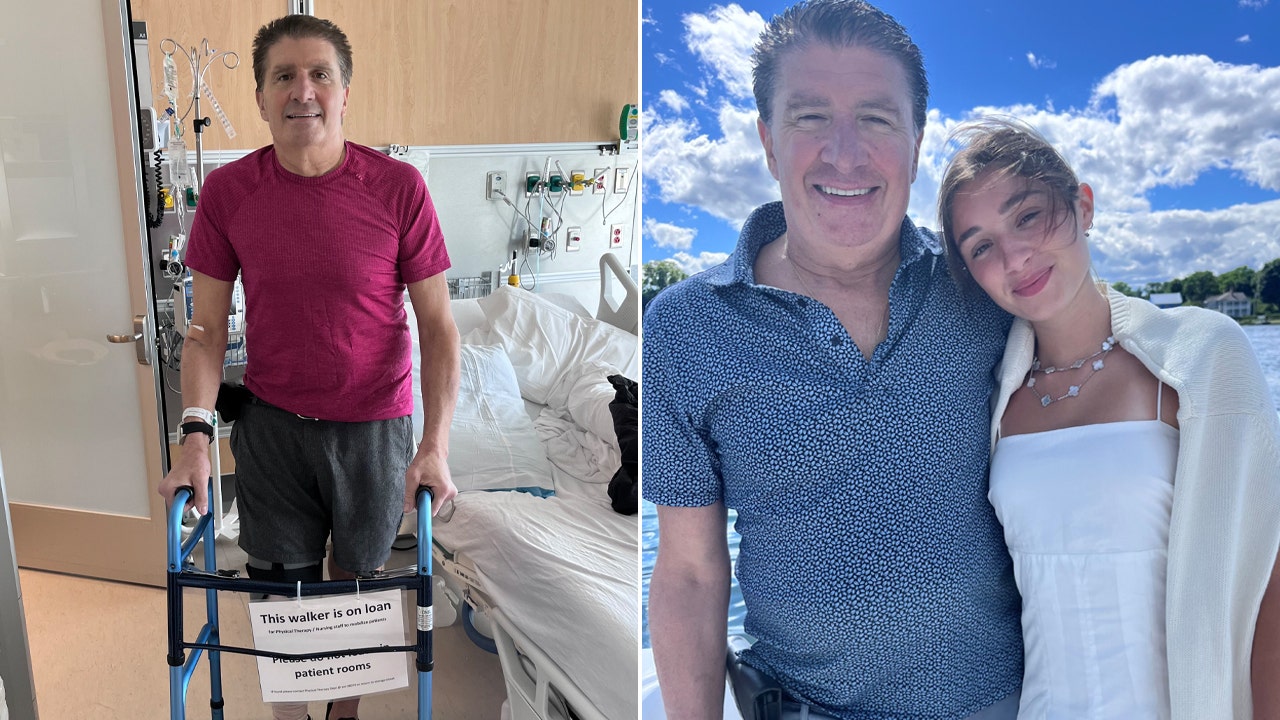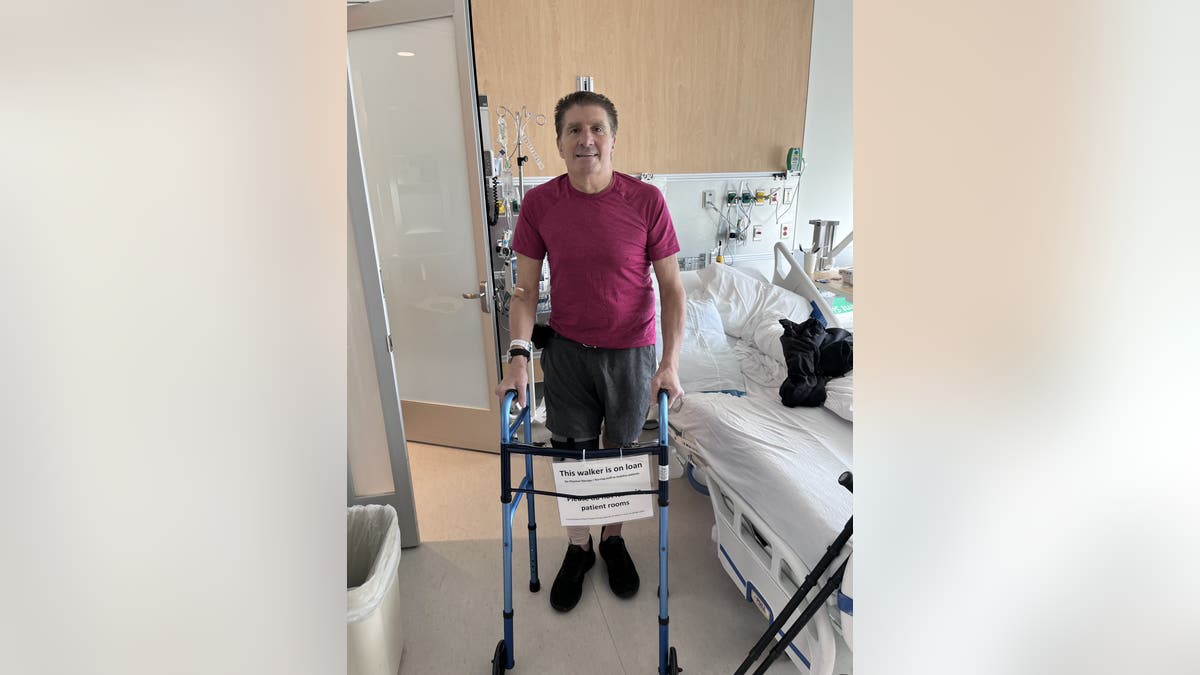Health
Cancer nearly took his leg, but this father of 6 is walking again: ‘I shouldn’t be here’

For one New York father of six who overcame the odds, this Father’s Day will be sweeter than most.
Richard Monti, a real estate developer who lives on Long Island, recently faced certain amputation after a life-threatening infection — until a determined doctor saved his leg with a complex surgery.
When Monti was diagnosed with metastatic kidney cancer in 2018, he thought that would be his toughest battle.
MELANOMA PATIENTS REVEAL DRAMATIC STORIES FOR SKIN CANCER AWARENESS MONTH: ‘I THOUGHT I WAS CAREFUL’
But after having surgery last year to repair his fractured upper shin bone — which had been damaged by years of cancer and radiation therapy — Monti developed sepsis, which threatened both life and limb.
Richard Monti, a real estate developer on Long Island, recently faced certain amputation after a life-threatening infection. A determined doctor was able to save his leg with a complex surgery. (Richard Monti)
It is relatively common for cancer patients to experience these types of fractures, according to Dr. Nicola Fabbri, chief of the Division of Orthopedic Oncology at NYU Langone Orthopedics, who treated Monti.
“When cancer is metastatic and goes to the bone, fractures do occur — it’s actually the main complication,” Fabbri told Fox News Digital in an interview.
“Probably 50% of people who develop bone metastases develop fractures.”
EXPERIMENTAL CANCER TREATMENT GIVES NEW JERSEY MOM A CHANCE FOR A SECOND BABY: ‘I DECIDED TO GO FOR IT’
While he was intubated and in a coma for several weeks, Monti underwent six surgeries to clean out the infection and try to restore his bones.
“They told my wife she should get prepared,” he told Fox News Digital in an interview. “They didn’t expect me to make it.”
Monti did pull through — but when he woke up, doctors delivered even more devastating news.

Richard Monti, center, is pictured with his family, who helped him get through his long ordeal. “I’m really living a normal life now,” he said. (Richard Monti)
“I was given basically one option, and that was amputation,” Monti, now 64, said in an interview with Fox News Digital.
The news sent Monti, who thrives on working on his feet, into a “very, very dark place.”
He said, “At that point, I was probably at my lowest. When my body moves, my mind moves. Losing that leg — I thought that was the way my story would end.”
“I was given basically one option, and that was amputation.”
Monti sought a second opinion from Dr. Fabbri of NYU Langone Orthopedics, who was highly recommended.
“When I met him, I loved what he said — ‘We don’t just cut legs off,’” Monti recalled.
After many tests and scans, the doctor told Monti he was “going back to the drawing board,” a nod to Monti’s building background.
“My wife and I started crying and smiling,” Monti recalled.

Dr. Nicola Fabbri, chief of the Division of Orthopedic Oncology at NYU Langone Orthopedics, was determined to save Monti’s leg. (Dr. Nicola Fabbri)
The doctor said he was hoping that given time, Monti’s sepsis would resolve, and his soft tissue would recover enough for a successful reconstruction surgery.
Monti’s case was complicated. He was dealing with an unhealed fracture of the upper part of his tibia, tissue damage from the sepsis infection, and significant bone loss and weakness from the radiation treatment for his cancer.
YOUNG GIRL SURVIVES CANCER THANKS TO LITTLE SISTER’S LIFESAVING DONATION: ‘A PERFECT MATCH’
“The sepsis was probably linked to being immunocompromised due to his cancer treatment,” Fabbri told Fox News Digital.
‘Performed miracles’
After Monti had some time to heal, he was deemed ready for surgery.
After 15 months of being in a brace and on crutches, Monti underwent a limb-preserving surgery consisting of a complex knee and tibia reconstruction.
While placing a new knee implant, Fabbri was able to correct the severe deformity caused by the fracture.
During the 11-hour surgery, which took place on Oct. 17 of 2023, the doctor also removed damaged parts of the tibia and replaced them with metal implants.

“That doctor and his team did perform miracles in my eyes,” Monti said of the surgery that saved his leg. (Richard Monti)
Now, Monti is pain-free, back to work — and able to walk without a cane or crutches.
“That doctor and his team did perform miracles in my eyes,” he said.
Monti still takes a chemotherapy pill once a day, and his tumors are now “very small, less than a centimeter.”
“For me to still be here — it means God’s got work for me to do.”
Although Fabbri has performed similar surgeries in the past, he noted that the circumstances of Monti’s challenges were “extremely rare.”
“This was a particularly challenging situation,” he said. “I never thought he could come back at this level. It’s really remarkable where he is today.”

Monti was able to walk on the beach just a couple of months after his surgery. “He can walk as tolerated with no support or limited support,” his doctor said. (Richard Monti)
Although Monti can’t run, he has “no substantial limitations” in his daily activities, his doctor told Fox News Digital.
“He can walk as tolerated with no support or limited support,” Fabbri said. “He sent me a video of him walking on the beach. It’s fantastic.”
CLICK HERE TO SIGN UP FOR OUR HEALTH NEWSLETTER
Throughout Monti’s darkest days, he said he drew strength from the love for his family — including his wife, five daughters and one son — and his faith.
“For me to still be here — it means God’s got work for me to do,” he said. “So I’m going to continue to do that work, because I honestly shouldn’t be here.”

Largely inspired by her father’s health journey, one of Monti’s daughters, pictured, has decided to pursue a career in nursing. “I’m so proud of her,” the dad said. (Richard Monti)
Recently, Monti was able to attend his daughter’s high school graduation, visit the college she will attend in the fall and enjoy a walk on the beach.
“It used to be that every step I took reminded me of cancer,” he said. “Every step was so painful. But now I really don’t think about it.”
“I’m living a normal life now.”
Largely inspired by her father’s health journey, one of Monti’s daughters has decided to pursue a career in nursing.
“Not everybody is so resilient.”
“I asked her why she was so determined to be a nurse,” Monti said. “She said, ‘Sitting there watching you all those months, I learned I had a lot to offer.’ I’m so proud of her.”
Fabbri credits Monti’s determination and positive outlook as being inextricably linked to his successful outcome.
For more Health articles, visit www.foxnews/health
“Not becoming discouraged and still willing to go ahead — it takes a lot of guts and determination,” he said.
“It takes a lot of strength to believe in yourself and your physician. Not everybody is so resilient.”

Health
Kristen Lost 55 Lbs With Zepbound After Breast Cancer

Use left and right arrow keys to navigate between menu items.
Use escape to exit the menu.
Sign Up
Create a free account to access exclusive content, play games, solve puzzles, test your pop-culture knowledge and receive special offers.
Already have an account? Login
Health
Hoda Kotb reveals daughter's concerning diagnosis influenced her exit from 'Today'

Hoda Kotb, longtime host of NBC’s “The Today Show,” is speaking out about the deeper reasons she decided to leave her post.
Kotb returned as a guest on Wednesday for the first time since her departure from “Today” in January.
During the appearance, she revealed that her younger daughter, Hope, 6, was diagnosed with type 1 diabetes.
WEIGHT LOSS, DIABETES DRUGS CAN CAUSE MOOD CHANGES: WHAT TO KNOW ABOUT BEHAVIORAL SIDE EFFECTS
Kotb, 60, noted that spending more time with both her daughters, including Haley, 8, was one of her motivations for leaving.
She told TODAY.com that Hope’s condition “definitely weighed in.”
Hoda Kotb is pictured with her daughter, Hope Catherine, on Jan. 10, 2025. (Nathan Congleton/NBC via Getty Images)
“As anyone with a child who has type 1, especially a little kid, you’re constantly watching, you’re constantly monitoring, you’re constantly checking, which is what I did all the time when I was [at ‘Today’],” she said. “You’re distracted.”
“You’re constantly watching, you’re constantly monitoring, you’re constantly checking.”
“You just get a priority check in your life,” Kotb expressed to co-anchors Savannah Guthrie and Craig Melvin during the segment. “I can be here and sweating what’s happening to Hope in the morning and in the night, or I can be there and feel relief.”
Kotb stressed that she tries not to “put her worry” on Hope, adding that her daughter is “fine for most of the day.”
DIABETES ‘REWIRES’ THE BRAIN IN SURPRISING WAY, STUDY FINDS
“There are just moments where you have to watch her,” Kotb said. “I was totaling it up — five minutes at breakfast, five minutes at lunch, five minutes at dinner, sometimes overnight.”
“Add that up, that’s a half-hour. So, for 23 ½ hours, she’s every other kid. So, I try to remember that.”

Hoda Kotb is pictured with daughters Hope and Haley Joy on her last day at “The Today Show” on Jan. 10, 2025. (Nathan Congleton/NBC via Getty Images)
The Cleveland Clinic defines type 1 diabetes as a chronic autoimmune disease that prevents the pancreas from producing insulin.
This requires daily management with insulin injections and blood sugar monitoring.
CLICK HERE TO SIGN UP FOR OUR HEALTH NEWSLETTER
Type 1 vs. type 2 diabetes
Type 1 diabetes occurs when the immune system “mistakenly attacks and destroys cells” in the pancreas, which can happen over months or years, the above source stated.
Symptoms of type 1 diabetes can include excessive thirst and hunger, frequent urination, unexplained weight loss, fatigue, blurred vision and slow healing of cuts and sores.

Type 1 diabetes requires daily management with insulin injections and blood sugar monitoring. (iStock)
In comparison, type 2 diabetes involves insulin resistance. This can cause the pancreas to not produce enough insulin and the body to not use the insulin as it should.
For more Health articles, visit www.foxnews.com/health
Obesity and lack of exercise, among other lifestyle and genetic factors, can contribute to the development of type 2 diabetes, according to experts.
Type 2 diabetes is more common than type 1 and is more likely to occur in older adults, while type 1 is most prevalent in children and young adults.

Hoda Kotb is pictured on “The Today Show” on Monday, Jan. 6, 2025. (Nathan Congleton/NBC via Getty Images)
Kotb shared with TODAY.com that Hope’s early symptoms mimicked the flu and were so severe that she had to be “raced” to the hospital.
“Let them be kids and give them what they need when they need it.”
Now that Kotb knows how to handle Hope’s condition, she’s offering her space to be a regular kid, she said.
“Don’t put your worry on your kid,” she advised fellow parents.
“Watch them, but don’t put your worry on them. Let them be kids and give them what they need when they need it.”
Health
I Lost Over 100 Lbs and Reversed Prediabetes—Without Surgery or Ozempic!

Use left and right arrow keys to navigate between menu items.
Use escape to exit the menu.
Sign Up
Create a free account to access exclusive content, play games, solve puzzles, test your pop-culture knowledge and receive special offers.
Already have an account? Login
-

 News1 week ago
News1 week agoMaps: 3.8-Magnitude Earthquake Strikes Southern California
-

 Culture1 week ago
Culture1 week agoDo You Know the English Novels That Inspired These Movies and TV Shows?
-

 Education1 week ago
Education1 week agoVideo: Columbia University President Is Booed at Commencement Ceremony
-

 Politics1 week ago
Politics1 week agoTrump, alongside first lady, to sign bill criminalizing revenge porn and AI deepfakes
-

 Education1 week ago
Education1 week agoHow Usher Writes a Commencement Speech
-

 Politics1 week ago
Politics1 week agoExpert reveals how companies are rebranding 'toxic' DEI policies to skirt Trump-era bans: 'New wrapper'
-

 World1 week ago
World1 week agoDigitisation fronts new Commission strategy to boost EU single market
-

 World1 week ago
World1 week agoEU reaches initial deal to lift economic sanctions on Syria: Reports















